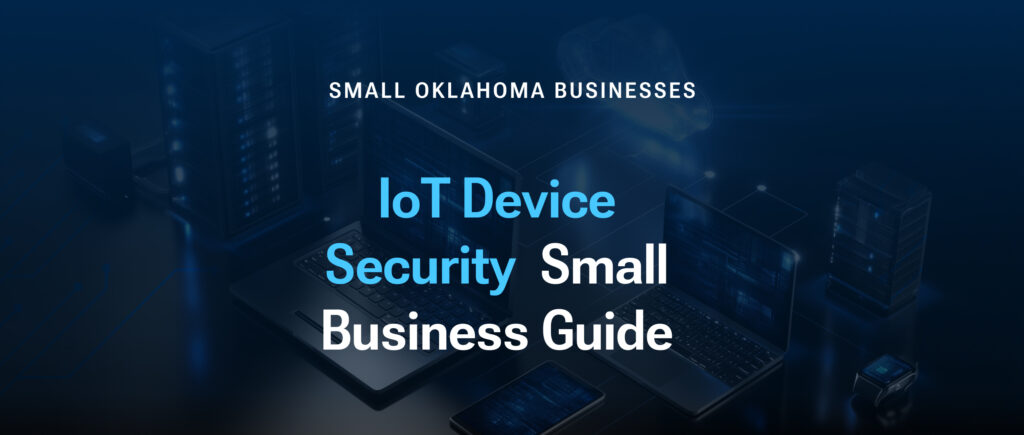Here’s something that keeps many Oklahoma business owners up at night: those convenient smart thermostats, security cameras, and wireless printers you installed to make operations smoother? They’ve quietly become potential doorways for cybercriminals to walk right into your business. What seemed like straightforward efficiency improvements—sensors keeping tabs on your equipment, smart locks managing access, wireless printers eliminating cable clutter—have actually expanded the number of ways hackers can target your company. The real challenge isn’t avoiding these helpful technologies but figuring out how to implement proper IoT device security small business strategies that actually protect your entire digital setup.
Here’s what makes IoT devices tricky: they’re nothing like the computers and servers you’re used to securing. Your laptops receive regular security updates, and your servers are monitored by IT professionals. But many of these connected gadgets? They’re running on default passwords that everyone knows, getting firmware updates maybe once a year if you’re lucky, and operating with practically no security oversight. This creates some serious weak spots in your overall network security that traditional computer security approaches just weren’t built to handle.
Understanding Smart Device Network Protection for Business Environments
Smart device network protection is a completely different animal than the security you’re used to dealing with. While your business computers and servers come equipped with solid security software and someone actually managing them, IoT devices often operate like they’re living in their own little world with barely any protection. These connected gadgets—everything from factory sensors to that fancy new smart coffee machine in the break room—are chattering away across your network without nearly the same level of security controls protecting your important business systems.
But here’s where it gets really concerning: these devices don’t just create individual security problems—they create highways that cybercriminals can use to hop around inside your business network. Think about it: a hacker compromises your smart printer, and suddenly they might have access to every document that gets printed. That vulnerable security camera you installed for peace of mind? It could become a window for criminals to peek into your broader network systems.
Common Business IoT Security Vulnerabilities
You’d be surprised how many connected devices Oklahoma businesses are running without really thinking through the security implications. Let’s look at what’s probably humming away in businesses across the state:
Manufacturing and Industrial IoT
- Sensors that keep track of how your production equipment is performing
- Systems that diagnose problems before machines break down
- Devices monitoring temperature, humidity, and other environmental factors
- Safety systems watching over employee well-being
Office and Administrative IoT
- Smart thermostats that adjust temperature automatically (and save on energy bills)
- Wireless printers and copiers that everyone connects to
- Access control systems and smart locks managing who gets in where
- Conference room tech, like smart displays and wireless presentation systems
Security and Surveillance IoT
- IP cameras keeping watch over your property
- Motion sensors and alarm systems protecting after hours
- Badge readers controlling access to sensitive areas
- Parking lot and perimeter security keeping unwanted visitors out
Each of these categories brings its own headaches when it comes to security, requiring specific IoT vulnerability management SMB approaches that actually make sense for your business.
Implementing Connected Device Endpoint Security Framework
Connected device endpoint security is a whole different ballgame compared to the computer security you’re probably familiar with. Traditional endpoint protection focuses on catching malware and stopping phishing emails—the software-based nasties that target your computers. But IoT security? You’re dealing with hardware vulnerabilities, firmware that rarely gets updated, and communication protocols that weren’t designed with security as the top priority.
Phase 1: IoT Device Discovery and Inventory
Before you can secure anything, you need to figure out precisely what connected devices are actually running in your business. Here’s something that might surprise you: most business owners discover they have way more IoT devices than they ever realized.
Network Scanning and Device Identification
- Use network discovery tools to find every single connected device (you’ll be amazed at what shows up)
- Write down what each device is, who made it, and what version of software it’s running
- Figure out how these devices talk to each other and what they connect to
- Find devices still using those embarrassing default passwords like “admin/password”
Business Impact Assessment
- Sort devices by how much trouble you’d be in if they got hacked
- Think through what would happen to your daily operations if specific devices went down
- Figure out what regulations apply to different types of devices you’re using
- Map out which devices have access to your really important business systems
Phase 2: Network Segmentation for IoT Security
Smart security implementation requires isolating IoT devices from critical business networks. This approach limits the potential damage from compromised devices while maintaining operational functionality.
IoT Network Isolation Strategies
- Create dedicated network segments for different device categories
- Implement VLAN separation between IoT and business networks
- Deploy firewalls to control communication between network segments
- Monitor and log all cross-network communication attempts
Access Control Implementation
- Establish role-based access controls for device management
- Implement strong authentication for all administrative functions
- Deploy certificate-based authentication where possible
- Regular review and update access permissions
Phase 3: Device Configuration and Hardening
Proper IoT vulnerability management SMB practices require securing each device according to manufacturer guidelines and industry best practices.
Security Configuration Standards
- Change all default passwords and usernames immediately
- Disable unnecessary services and communication protocols
- Enable encryption for all device communications
- Configure secure firmware update mechanisms
Ongoing Device Management
- Establish regular firmware update schedules
- Monitor device health and security status continuously
- Implement automated alerting for device anomalies
- Maintain configuration backup and recovery procedures
Real-World Oklahoma Business IoT Security Scenarios
Understanding how IoT device security strategies for small businesses apply to actual Oklahoma operations helps illustrate practical implementation approaches.
Example: Healthcare Practice IoT Security
A medical practice in Oklahoma City implements connected patient monitoring devices, smart climate controls, and wireless medical equipment. Their IoT security strategy includes network segmentation to isolate medical devices from administrative systems, ensuring HIPAA compliance while maintaining operational efficiency. Connected devices communicate through dedicated networks with restricted access to patient data systems.
Example: Manufacturing Facility Connected Infrastructure
A Tulsa manufacturing company deploys industrial IoT sensors to monitor production equipment, environmental conditions, and safety systems. Their connected device endpoint security framework includes isolated operational technology networks, encrypted communication protocols, and continuous monitoring of all industrial control systems. Smart security measures prevent cyber attacks from disrupting production operations.
Example: Professional Services Firm Smart Office
An accounting firm in Norman implements smart building controls, connected printers, and wireless presentation systems. Their IoT vulnerability management approach includes regular security assessments, firmware update management, and network monitoring to protect client financial data from potential device-based attacks.
Advanced Network Security for IoT Environments
Comprehensive IoT security requires advanced network security measures that extend beyond basic device protection. Oklahoma businesses must implement monitoring and response capabilities designed explicitly for connected device environments.
Continuous Monitoring and Threat Detection
Behavioral Analysis for IoT Devices
- Monitor standard communication patterns for each device type
- Detect anomalous behavior that might indicate compromise
- Implement automated response procedures for security incidents
- Maintain detailed logs of all device activities and communications
Integration with Security Operations
- Connect IoT monitoring to existing security information systems
- Develop incident response procedures specific to device compromise
- Train staff on IoT-specific security procedures and protocols
- Regular testing of security controls and response capabilities
Compliance and Regulatory Considerations
Different industries face specific regulatory requirements for connected device security. Oklahoma businesses must ensure their IoT implementations meet relevant compliance standards.
Industry-Specific Requirements
- Healthcare organizations must address HIPAA implications of connected devices
- Financial services face regulatory scrutiny for client data protection
- Manufacturing companies must consider industrial control system security
- Government contractors require additional security controls for connected infrastructure
Building Sustainable IoT Security Operations
Successful IoT device security implementations in small businesses require ongoing operational commitment rather than one-time setup activities. Oklahoma businesses must develop sustainable processes for managing connected device security throughout their operational lifecycle.
Vendor Management and Procurement
Security-First Procurement Processes
- Evaluate security capabilities before purchasing IoT devices
- Require vendor security documentation and support commitments
- Establish security requirements in procurement contracts
- Plan for end-of-life security considerations during initial deployment
Ongoing Vendor Relationships
- Monitor vendor security advisories and updates regularly
- Maintain communication channels for security incident coordination
- Evaluate vendor security practices through regular assessments
- Plan replacement strategies for devices with inadequate security support
Staff Training and Security Awareness
Connected device security requires business-wide awareness and participation. Staff must understand how their interactions with IoT devices impact the overall security posture.
Employee Education Programs
- Train staff on proper device usage and security procedures
- Develop incident reporting processes for suspicious device behavior
- Provide regular updates on emerging IoT security threats
- Create clear policies for personal device connections to business networks
Measuring IoT Security Program Effectiveness
Successful smart device network protection requires continuous measurement and improvement. Oklahoma businesses should establish metrics that demonstrate security program effectiveness and identify areas for enhancement.
Key Performance Indicators
Security Metrics
- Number of discovered vulnerabilities and remediation timeframes
- Incident response times for IoT-related security events
- Compliance audit results for connected device security
- Staff security awareness training completion and effectiveness
Operational Metrics
- Device uptime and availability measurements
- Network performance impact from security controls
- Cost-effectiveness of security investments versus risk reduction
- Integration success with existing business systems
Securing Your Oklahoma Business’s Connected Future
The Internet of Things is not a temporary technology trend—it represents the future of business operations across industries. Oklahoma companies that proactively address IoT device security small business challenges position themselves for sustainable growth while protecting critical business assets.
The question facing business owners is not whether to embrace connected technologies but how to implement them securely. Every day of delay in developing comprehensive IoT security strategies increases your business’s exposure to cyber threats that specifically target vulnerable connected devices.
Smart security requires more than hoping your devices remain secure—it demands proactive planning, implementation, and ongoing management. The cost of inadequate IoT security extends beyond potential data breaches to include operational disruption, compliance violations, and competitive disadvantage.
Ready to secure your business’s connected infrastructure?
Our cybersecurity experts specialize in IoT vulnerability management SMB solutions for Oklahoma businesses. We provide comprehensive assessments of your current connected device environment, develop customized security frameworks that align with your operational needs, and deliver ongoing support to ensure your IoT investments enhance rather than compromise your business security. Schedule your confidential IoT security consultation today and discover how proper connected device endpoint security can support your business growth while protecting your most valuable assets.

